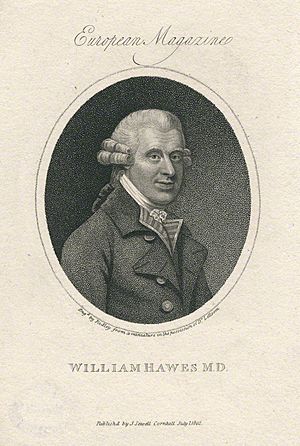William Hawes (physician) facts for kids
William Hawes (born 1736, died 1808) was an English doctor and a kind-hearted person who helped others. He is famous for starting the Royal Humane Society. This society helped teach people how to save lives, especially those who had almost drowned. William Hawes also cared a lot about helping people who were poor in London.
Contents
Early Life and Medical Career
William Hawes was born in Islington, London, on November 28, 1736. He went to school at St Paul's School, London. After his schooling, he worked with a doctor named Mr. Robert Carsan in Vauxhall. Later, he became an assistant to another doctor, Mr. Dicks, in an area of London called the Strand. Eventually, William Hawes took over Mr. Dicks' medical practice.
Saving Lives: The Humane Society
Around 1773, William Hawes became very well known for his efforts to bring people back to life who seemed to have died from drowning or other causes where they couldn't breathe. This process is called resuscitation.
For a whole year, he offered a reward to anyone who brought him a person who had been pulled out of the River Thames and seemed unconscious. He paid the reward whether the person was saved or not. He wanted to encourage people to try and help.
Another person, Thomas Cogan, who had learned about a similar society in Amsterdam, thought that William Hawes shouldn't have to pay all the rewards himself. So, in 1774, they decided to invite friends to a meeting at a coffee house in London. At this meeting, they officially formed the Humane Society. William Hawes became the person in charge of keeping its records.
Helping the Community
Besides his work with the Humane Society, William Hawes was also a doctor at the London Dispensary, which was like a clinic for people who couldn't afford a private doctor. From 1791, he lived in an area called Spital Square. In 1793, he worked hard to help the Spitalfields weavers, who were facing tough times and poverty. He passed away on December 5, 1808.
What William Hawes Wrote
William Hawes wrote several books and papers, mostly about health and saving lives:
- An Account of Dr. Goldsmith's Illness, 1774. This was about the sickness of a famous writer, Oliver Goldsmith.
- An Address on Premature Death and Premature Interment, 1777. This discussed the dangers of burying people too soon if they only seemed dead.
- An Address to the Public on the Dangerous Custom of laying out persons as soon as Respiration ceases, 1778. This was another warning about making sure someone was truly gone before preparing them for burial.
- An Address to the Legislature on the importance of a Humane Society, 1781. This explained to lawmakers why the Humane Society was so important.
- An Address to the King and Parliament of Great Britain on the important subject of preserving the Lives of its Inhabitants, 1782. This was a message to the government about protecting the lives of people in Britain.
- The Transactions of the Royal Humane Society from 1774 to 1784, which included notes on how to help people who had stopped breathing.
His Family
William Hawes married Sarah Fox in 1759, and they had nine children. Some of their children included:
- Harriot (born 1760)
- Sophia (born 1762, died 1828)
- Thomas (born 1765, died 1849), who became a magistrate and worked in a soap business.
- Sarah (born 1773)
- William (born 1774)
- Benjamin (1770–1861), who was the father of two other notable people also named Benjamin Hawes and William Hawes (1805–1885).
- Maria, or Mary Ann (born 1782)


